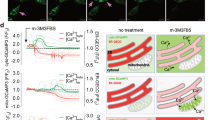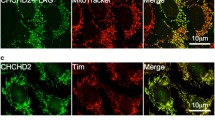Abstract
Bax, a pro-apoptotic member of the Bcl-2 family of proteins has the ability to form transmembrane pores large enough to allow cytochrome c (Cyt c) release, as well as to activate the mitochondrial permeability transition pore (mPTP); however, no differential study has been conducted to clarify which one of these mechanisms predominates over the other in the same system. In the present study, we treated isolated mitochondria from MCF7 cells with recombinant protein Bax and tested the efficacy of the mPTP inhibitor cyclosporin A (CsA) and of the Bax channel blocker (Bcb) to inhibit cytochrome c release. We also, induced apoptosis in MCF7 cell cultures with TNF-α plus cycloheximide to determine the effect of such compounds in apoptosis induction via mPTP or Bax oligomerization. Cytochrome c release was totally prevented by CsA and partially by Bcb when apoptosis was induced with recombinant Bax in isolated mitochondria from MCF7 cells. CsA increased the number of living cells in cell culture, as compared with the effect of Bax channel blocker. These results indicate that mPTP activation is the predominant pathway for Bax-induced cytochrome c release from MCF7 mitochondria and for apoptosis induction in the whole cell.
Similar content being viewed by others
References
Antonsson B, Conti F, Ciavatta A, Montessuit S et al (1997) Inhibition of Bax channel-forming activity by Bcl-2. Science 277:370–372
Baines CP, Kaiser RA, Sheiko T, Craigen WJ, Molkentin JD (2007) Voltage-dependent anion channels are dispensable for mitochondrial-dependent cell death. Nat Cell Biol 9(5):550–5
Banerjee J, Ghosh S (2004) Bax increases the pore size of rat brain mitochondrial voltage-dependent anion channel in the presence of tBid. Biochem Biophys Res Commun 323:310–314
Bedner E, Smolewski P, Amstad P, Darzynkiewicz Z (2000) Activation of caspases measured in situ by binding of fluorochrome-labeled inhibitors of caspase (FLICA): correlation with DNA fragmentation. Exp Cell Res 259:308–313
Binder C, Binder L, Kroemker M, Schultz M, Hiddemann W (1997) Influence of cycloheximide-mediated downregulation of glucose transport on TNF alpha-induced apoptosis. Exp Cell Res 236:223–230
Bombrun A, Gerber P, Casi G, Terradillos O, Antonsson B, Halazy S (2003) 3,6-Dibromocarbazole piperazine derivatives of 2-propanol as first inhibitors of cytochrome c release via Bax channel modulation. J Med Chem 46:4365–4368
Brunelle JK, Letai A (2009) Control of mitochondrial apoptosis by the Bcl-2 family. J Cell Sci 122:437–441
Chang LK, Putcha GV, Deshmukh M, Johnson EM Jr (2002) Mitochondrial involvement in the point of no return in neuronal apoptosis. Biochimie 84:223–231
Dressler K, Mathias S, Kolesnick N (1992) Tumor necrosis factor-α activates the sphingomyelin signal transduction pathway in a cell-free system. Science 255:1715–1718
Gustafsson AB, Gottlieb R (2007) Bcl-2 Family members and apoptosis, taken to heart. Am J Physiol Cell Physiol 292:C45–C51
Gustafsson AB, Gottlieb RA (2008) Heart mitochondria: gates of life and death. Cardiovasc Res 77:334–343
Halestrap AP, Connern CP, Griffiths EJ, Kerr PM (1997) Cyclosporin A binding to mitochondrial cyclophilin inhibits the permeability transition pore and protects hearts from ischemia/reperfusion injury. Mol Cell Biochem 174:167–172
Hetz C, Vitte PA, Bombrun A, Rostovtseva TK, Montessuit S, Hiver A, Schwarz MK, Church DJ, Korsmeyer SJ, Martinou JC, Antonsson B (2005) Bax channel inhibitors prevent mitochondrion-mediated apoptosis and protect neurons in a model of global brain ischemia. J Biol Chem 280:42960–42970
Ivashyna O, García-Sánz AJ, Ries J, Christenson ET, Schwille P, Schlesinger PH (2009) Detergent-activated BAX protein is a monomer. J Biol Chem 284:23935–23946
Jarvis WD, Kolesnick RN, Fornari FA, Traylor RS, Gewirtz DA, Grant S (1994) Induction of apoptotic DNA damage and cell death by activation of the sphingomyelin pathway. Proc Natl Acad Sci USA 91:73–77
Kuwana T, Mackey MR, Perkins G, Ellisman MH, Latterich M, Schneiter R, Green DR, Newmeyer DD (2002) Bid, Bax and lipids cooperate to form supramolecular openings in the outer mitochondrial membrane. Cell 111:331–342
Li P, Nijhawan D, Budihardjo I, Srinivasula SM, Ahmad M, Alnemri ES, Wang X (1997) Cytochrome c and dATP-dependent formation of Apaf-1/caspase-9 complex initiates an apoptotic protease cascade. Cell 91:479–489
Lopez-Marure R, Ventura JL, Sanchez L, Montaño LF, Zentella A (2000) Ceramide mimics tumor necrosis factor-alpha in the induction of cell cycle arrest in endothelial cells. Induction of the tumor suppressor p53 with decrease in retinoblastoma/protein levels. Eur J Biochem 267:4325–4333
Marin-Hernandez A, Garcia-Mora I, Ruiz-Ramirez L, Moreno-Sanchez R (2003) Toxic effects of copper-based antineoplastic drugs (Casiopeinas) on mitochondrial functions. Biochem Pharmacol 65:1979–1989
Martínez-Abundis E, Correa F, Pavón N, Zazueta C (2009) Bax distribution into mitocondrial detergent-resistant microdomains is related to ceramide and cholesterol content in postinchemic hearts. FEBS J 276:5579–5588
Martinez-Abundis E, Garcia N, Correa F, Franco M, Zazueta C (2007) Changes in specific lipids regulate Bax-induced mitochondrial permeability transition. FEBS J 274:6500–6510
McGuinness O, Yafei N, Costi A, Crompton M (1990) The presence of two classes of high-affinity cyclosporin A binding sites in mitochondria. Evidence that the minor component is involved in the opening of an inner-membrane Ca(2+)-dependent pore. Eur J Biochem 194:671–679
Merlini L, Angelin A, Tiepolo T, Braghetta P, Sabatelli P, Zamparelli A, Ferlini A, Maraldi NM, Bonaldo P, Bernardi P (2008) Cyclosporin A corrects mitochondrial dysfunction and muscle apoptosis in patients with collagen VI myopathies. Proc Natl Acad Sci USA 105:5225–5229
Narita M, Shimizu S, Ito T, Chittenden T, Lutz RJ, Matzuda H, Tsujimoto Y (1998) Bax interacts with the permeability transition pore to induce permeability transition and cytochrome c release in isolated mitochondria. Proc Natl Acad Sci USA 95:14681–14686
Petros AM, Olejniczak ET, Fesik SW (2004) Structural biology of the Bcl-2 family of proteins. Biochem Biophys Acta 1644:83–94
Rostovtseva TK, Antonsson B, Suzuki M, Youle RJ, Colombini M, Bezrukov SM (2004) Bid, but not Bax, regulates VDAC channels. J Biol Chem 279:13575–83
Scaffidi C, Fulda S, Srinivasan A, Friesen C, Li F, Tomaselli KJ, Debatin KM, Krammer PH, Peter ME (1998) Two CD95 (APO-1/Fas) signaling pathways. EMBO J 17:1675–1687
Schendel SL, Montal M, Reed JC (1998) Bcl-2 family proteins as ion-channels. Cell Death Differ 5:372–380
Shimizu S, Ide T, Yanagida T, Tsujimoto Y (2000) Electrophysiological study of a novel large pore formed by Bax and the voltage-dependent anion channel that is permeable to cytocrome c. J Biol Chem 275:12321–12325
Siskind LJ, Kolesnick R, Colombini M (2002) Ceramide channels increase the permeability of the mitochondrial outer membrane to small proteins. J Biol Chem 277:26796–26803
Susin SA, Zamzami N, Kroemer G (1998) Mitochondria as regulators of apoptosis: Doubt no more. Biochim Biophys Acta 1366:151–165
Tsujimoto Y, Shimizu S (2000) VDAC regulation by Bcl-2 family of proteins. Cell Death Differ 7:1174–1181
Vyssokikh M, Zorova L, Zorov D, Heimlich G, Jurgensmeier J, Brdiczka D (2002) Bax releases cytochrome c preferentially from a complex between porin and adenine nucleotide translocator. Hexokinase activity suppresses this effect. Mol Biol Rep 29:93–96
Xie Z, Schendel S, Matsuyama S, Reed J (1998) Acidic pH promotes dimerization of Bcl-2 family of proteins. Biochemistry 37:6410–6418
Author information
Authors and Affiliations
Corresponding author
Additional information
Nancy P. Gómez-Crisóstomo, Rebeca López-Marure and Estrella Zapata are contributed equally to this study.
Rights and permissions
About this article
Cite this article
Gómez-Crisóstomo, N.P., López-Marure, R., Zapata, E. et al. Bax induces cytochrome c release by multiple mechanisms in mitochondria from MCF7 cells. J Bioenerg Biomembr 45, 441–448 (2013). https://doi.org/10.1007/s10863-013-9508-x
Received:
Accepted:
Published:
Issue Date:
DOI: https://doi.org/10.1007/s10863-013-9508-x




